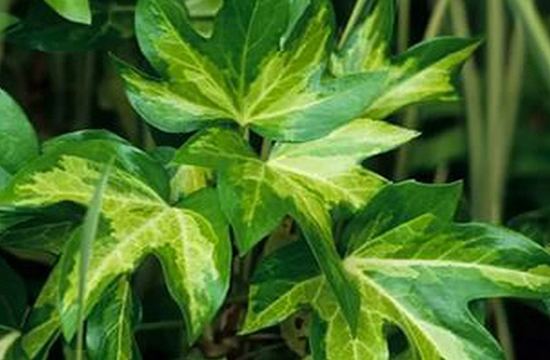
Fatshedera (Fatshedera) – a plant of the Araliaceae family. This is a garden form obtained as a result of hybridization between Japanese Fatsia and one of the ivy species.
This culture is most often used for growing in rooms, but in the southern regions it can also grow in open ground. So, for example, it is often planted on personal plots in the south of the Krasnodar Territory, in the Crimea and Abkhazia.

Description of types and varieties of fatsheders (with photo)
Fatsheder – unpretentious ornamental plant with lignified shoots, up to 5 m long.

Where the stem meets the soil, additional roots usually appear to provide additional nourishment to this already fast growing plant. The annual growth is about 25 cm or more.
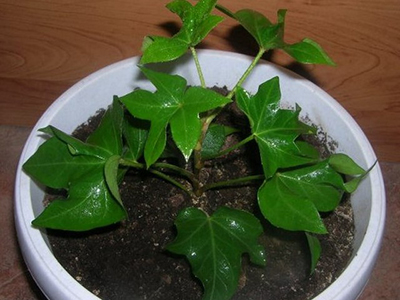
In young individuals, the stems are smooth, light green. With age, they become lignified, become rough, acquire a brown tint.

In the absence of support, the fatshedera flower leans towards the ground very quickly and grows horizontally.

The leaves are dark green, leathery, large, petiolate, 3-5-lobed (depending on the variety), with a glossy surface, smooth or slightly wavy along the edge, pointed at the end.
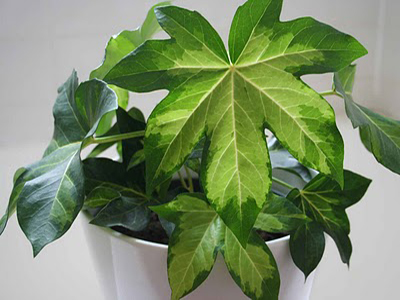
There are variegated forms.
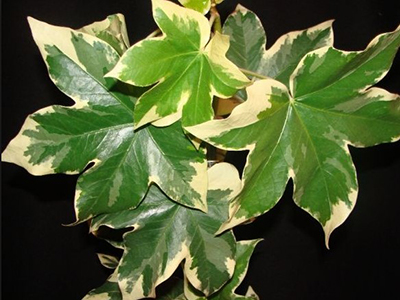
In late summer – early autumn, inflorescences – umbrellas – form in the axils of the leaves.
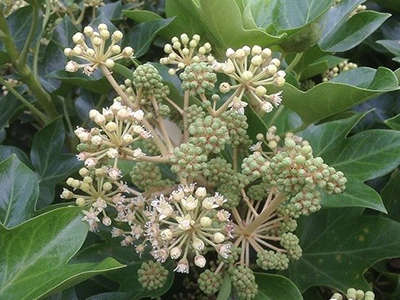
The flowers are small, greenish-yellow. A lot of them can develop on one plant, but they do not represent decorative value. Flowers give fruit very rarely, in isolated cases small burgundy berries with seeds appear on the plant.

.
By pinching the shoots, you can get the desired shape of the fatshedera flower, which can be seen in the photo below, for example, in the form of a bush or a complex green sculpture.
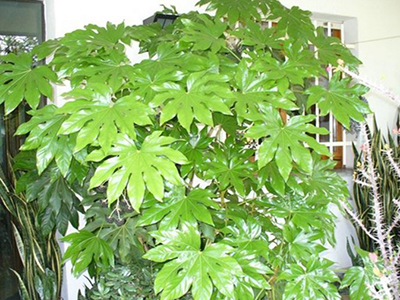

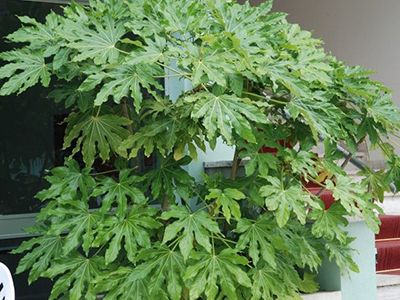
Below is a description of the most popular home-grown varieties and types of fatshedera, with a photo.
Varieties of Fatheaders:
“Variegata” (Variegata) – a variety with large leathery leaves with deep light veins and cream edging along the edges.
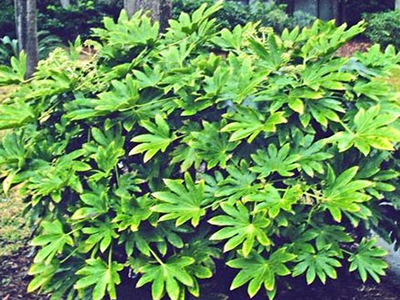
Fatsheder “Pia” (Pia) – a variety with large dark green dense leaves, which are framed by a white border.
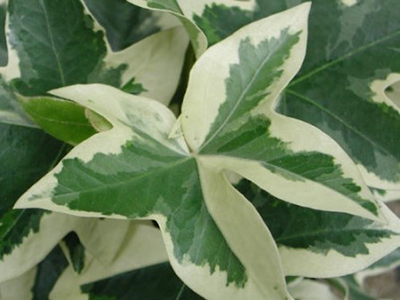
Fatsheder “Silver Prince” (Silver Prince) – a variety with spectacular shiny dark green leaves with a silvery sheen.
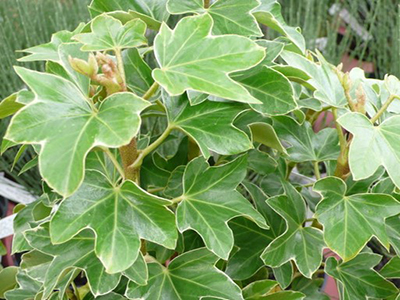
“Annemieke” (Annmike) – one of the most beautiful varieties of fatshedera, characterized by an extraordinary color of the leaf plate. Its central part is yellow-green, and the shades of the edges can vary from dark green to emerald green.

“Aureopicta” (Aureopicta) – a variety with compact leaf sizes and variegated color.
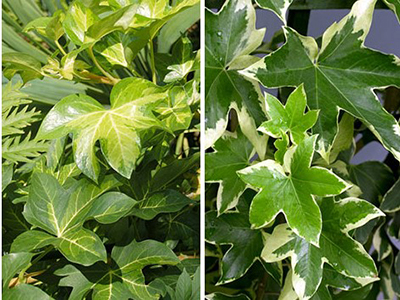
“Aurea” (Aurea) – the central part of the leaf plate is light green or yellowish, the edges are dark green.

Fatshedera “Angyo Star” (Angio Star) – a variety with large dark green leaves and a cream pattern on their surface.
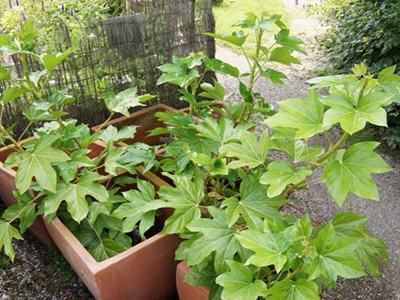
Fatshedera “Lemon and lime” (Lemon and lime) – the variety is distinguished by dark green leaf plates with a pattern of light and dark yellow-green spots scattered over them.
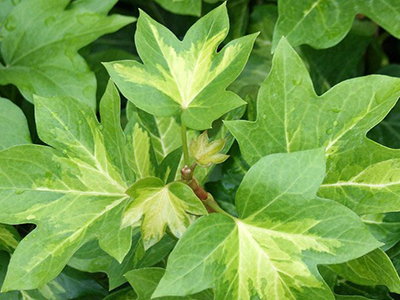
There is only one type of fatshedera – Lise, which is a creeper with a creeping dark green stem, on which are alternate, palmate-lobed leaves with long petioles.
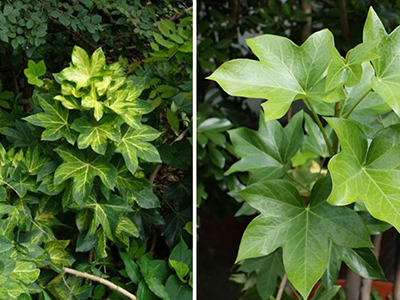
Leaf plates have a smooth, shiny surface and rich green color. The length of the leaf reaches 20 cm or more. The flowers are pale yellow or cream, with a white core, collected in inflorescences, umbrellas, attached to short peduncles.
Growing fatsheders indoors
The fatshedera indoor flower is unpretentious and shade-tolerant, however, not all flower growers manage to grow it healthy and lush. When breeding, it is worth considering the characteristics of this plant.
Location. It is believed that this culture can successfully grow in the shade, but in practice it develops better with good lighting, even in winter. For her, the best place in the house will be the western or eastern window. The south side is not recommended for a permanent location of fatheaders, as the sun’s rays can cause burns to its leaves. Variegated varieties of this plant need an abundance of sunlight. In the shade and partial shade, they lose their pattern, and hence their decorative effect.
Temperature. When caring for a fatshedera, it is necessary to create a moderate air temperature in the warm season (from 20 degrees and above), and in winter not higher than 20 degrees and not lower than 10 degrees. Ivy freely tolerates dry indoor air.
In winter, an exotic flower needs a dormant period. At this time, it should be removed to a cool place, for example, to a loggia, where there will be enough sunlight. You can keep it in the winter in the apartment, but place it on the windowsill with a temperature slightly lower than in the room.
Watering. From spring to autumn, when caring for a fatshedera at home, abundant watering is required, but moisture stagnation in the soil should not be allowed. To prevent this from happening before watering, check how dry the earthen ball is. If the soil is half dry, you can water the plant. In winter, watering is done less frequently – as the soil coma dries up.
Fatshedera has large, dense leaves that evaporate a lot of moisture, the reserves of which must be replenished to avoid yellowing and drying out. To do this, it is useful to arrange water procedures: spray ivy with soft warm water from a spray bottle, put it in the shower, or wipe the leaves with a damp cloth. During the rest period, this work is not necessary.
substrate. The soil should be loose, with neutral acidity. The substrate is made up of soddy land, humus and sand (2:1:1). In order to prevent stagnation of water in the tank, it is necessary to arrange drainage from a mixture of expanded clay, broken brick, filled up to 0.3 of the height of the tank.
Top dressing. When caring for a fatshedera flower from March to August, it is fed with fertilizers for decorative foliage plants with a high nitrogen content. They should be applied in the spring-summer period, increasing the volume during the growing season.
Transplants. In order to get a lush bush, young plants are transplanted annually, choosing a capacity slightly larger than the previous one. Adults need to be transplanted once every 4 years.
Pruning. Fatshedera responds well to shaping, so it is easy for the grower to give the ivy the desired shape by directing the branches to the desired position: up along the created support, or down, hanging long shoots from the pots. Ladders, arches, cones and other structures are perfect as supports. With the help of such a flower, the most complex plant compositions are created.
In order for more shoots to appear on the plant, it is pruned. This helps to make it lush and bushy. You can achieve maximum splendor by planting several ivy seedlings in one pot.
You can learn more about how to take care of a fatshedera at home by looking at the photos below.
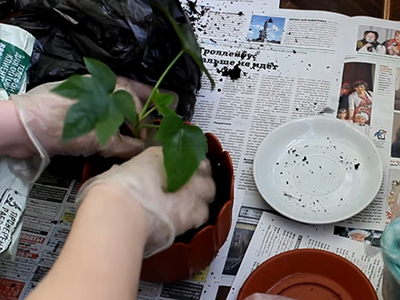


When growing a plant, some difficulties may arise. The main ones are listed below. Yellowing and dropping of leaves. Reason: improper care of the plant.
Brown spots on the leaves are the result of exposure to direct sunlight.
Sometimes on the shoots you can find a fluffy coating that looks like mold. This suggests that the fatshedera was struck by the gray rot disease. To cure ivy, you should remove the rotten parts and treat the flower with fungicides.
For the prevention of diseases, it is necessary to create optimal conditions for the normal growth and development of indoor ivy.
Watch a video on how to care for fatshedera at home, which will help to avoid many mistakes when breeding exotic ivy and grow a lush, beautiful bush.
Propagation of fatshedera by apical or stem cuttings
Fatsheders are propagated in August by apical or stem cuttings with 2-3 internodes. For rooting, a mini greenhouse is prepared by choosing a small container for this and filling it with a substrate of sand and peat, taken in equal proportions. Before planting the cuttings, the soil must be moistened, then the seedlings should be deepened by 1–2 cm and covered with foil or glass. Remove the greenhouse in a warm, well-lit place.
To achieve a good result, seedlings should be taken care of daily, which will consist of airing the greenhouse and watering. Under favorable conditions, the cuttings will take root in a week. When the plants get stronger, they can be planted in separate small pots. You should not plant them in a large bowl, as the empty soil can quickly turn sour, and this will lead to decay of the root system. It is best to change the container for ivy as it grows.
Propagation of fatshedera by cuttings, as a rule, is carried out quite successfully and allows you to get new strong and healthy plants in a short time.







